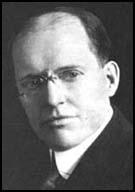Carr Van Anda

Carr Van Anda was born in Georgetown, Ohio, on 2nd December, 1864. After studying astronomy and physics at Ohio University, he became a reporter for the Cleveland Herald.
In 1886 he was appointed night editor of the Baltimore Sun and two years later did the same job for the New York Sun. He was especially keen to increase the scientific news coverageof the newspaper.
In 1904 Adolph Ochs the owner of the New York Times, appointed Van Anda as managing editor. Obsessed with reporting every major story in great detail, Ochs worked twelve hours a day, seven days a week. As one historian of the newspaper has pointed out: "He loved to match his speed and wits against a deadline. But he never lost sight of the importance of conscientious and intelligent handling of the bulk of the news, and he transmitted this spirit to his staff."
One of Van Anda's many success stories was the way he reported the sinking of the Titanic. At 1:20 a.m. on 15th April, 1912, the New York Times newsroom received information about the Titantic SOS via the Marconi wireless station in Newfoundland. Van Anda contacted his correspondents in Halifax and Montreal who were able to find out that the ship's wireless had fallen silent 30 minutes after the first call for help. By consulting the newspaper's detailed news library Van Anda discovered that other ships had recently reported close scrapes with icebergs in this area. The next morning th newspaper reported on its front page that the ship had sunk while other papers in America were handling the story in incomplete and inconclusive manner.
During the First World War the New York Times began to publish the texts of documents and speeches in full. The compilation of the New York Times Index ensured that it became the nation's leading reference newspaper for students, librarians, historians, and journalists.
The newspaper continued to prosper under Van Anda's management and by 1921 circulation had reached 330,000 during the week and 500,000 on Sunday. At the same time advertising had increased tenfold in 25 years.
Van Anda took a strong interest in archaeology and secured near-exclusive coverage of the opening of Tutankhamun's tomb by Howard Carter in 1923. He retired from the New York Times in 1932,
Carr Van Anda died of a heart-attack on 28th January, 1945, after hearing of the death of his daughter.
